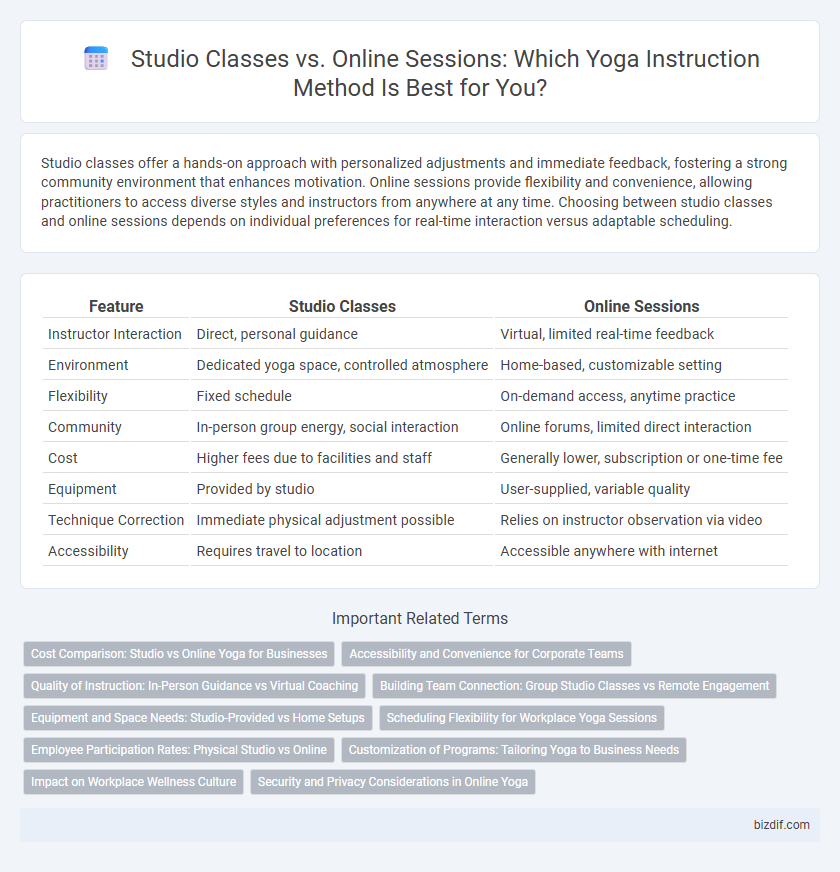Studio classes offer a hands-on approach with personalized adjustments and immediate feedback, fostering a strong community environment that enhances motivation. Online sessions provide flexibility and convenience, allowing practitioners to access diverse styles and instructors from anywhere at any time. Choosing between studio classes and online sessions depends on individual preferences for real-time interaction versus adaptable scheduling.
Table of Comparison
| Feature | Studio Classes | Online Sessions |
|---|---|---|
| Instructor Interaction | Direct, personal guidance | Virtual, limited real-time feedback |
| Environment | Dedicated yoga space, controlled atmosphere | Home-based, customizable setting |
| Flexibility | Fixed schedule | On-demand access, anytime practice |
| Community | In-person group energy, social interaction | Online forums, limited direct interaction |
| Cost | Higher fees due to facilities and staff | Generally lower, subscription or one-time fee |
| Equipment | Provided by studio | User-supplied, variable quality |
| Technique Correction | Immediate physical adjustment possible | Relies on instructor observation via video |
| Accessibility | Requires travel to location | Accessible anywhere with internet |
Cost Comparison: Studio vs Online Yoga for Businesses
Studio yoga classes typically involve higher expenses, including rent, utilities, and instructor salaries, resulting in substantial overhead for businesses. Online yoga sessions eliminate many fixed costs, allowing companies to offer more affordable enrollment fees and reach a broader audience without geographic limitations. Comparing cost-efficiency, online platforms deliver scalable solutions, reducing per-employee costs while maintaining quality instruction.
Accessibility and Convenience for Corporate Teams
Studio classes offer a structured environment with hands-on guidance, fostering team bonding through in-person interaction, while online sessions provide unparalleled accessibility by accommodating diverse schedules and remote locations. For corporate teams, virtual yoga platforms support flexibility, allowing employees to join from home or office without commuting constraints, enhancing participation rates. Integrating online classes with real-time feedback tools ensures personalized instruction, making wellness programs more inclusive and convenient for global teams.
Quality of Instruction: In-Person Guidance vs Virtual Coaching
Studio classes offer personalized, in-person guidance that allows instructors to correct posture and alignment in real-time, ensuring optimal form and reducing injury risk. Online sessions provide convenient access to diverse yoga styles but often rely on verbal cues and limited visual feedback, which can challenge precise adjustments. The tactile experience and immediate interaction in studio settings typically enhance the overall quality of instruction compared to virtual coaching.
Building Team Connection: Group Studio Classes vs Remote Engagement
Group studio classes foster stronger team connections through in-person interaction, shared energy, and immediate feedback from instructors and peers. In contrast, online sessions rely on virtual communication tools that can limit spontaneous social bonding and subtle nonverbal cues essential for team cohesion. Physical presence in studio classes enhances trust and collaboration, making them more effective for building a unified yoga community.
Equipment and Space Needs: Studio-Provided vs Home Setups
Studio classes offer fully equipped spaces with yoga mats, blocks, straps, and ample room designed for optimal movement and alignment, eliminating the need for personal equipment investment. Online sessions require participants to create a suitable home setup, often needing to purchase basic equipment such as non-slip mats and blocks while ensuring sufficient space for poses without distractions. Proper space and equipment availability directly impact practice quality, with studios providing a controlled environment and online classes relying on individual preparation for safety and effectiveness.
Scheduling Flexibility for Workplace Yoga Sessions
Studio classes for workplace yoga sessions offer fixed schedules that require employees to align their workday accordingly, which can limit flexibility. Online sessions provide adaptable timing options, allowing participants to practice yoga during breaks or outside standard office hours, enhancing convenience. This flexibility in online scheduling supports better integration of yoga into employees' diverse routines, promoting consistent engagement and improved workplace wellness.
Employee Participation Rates: Physical Studio vs Online
Employee participation rates in physical yoga studio classes typically surpass those of online sessions, driven by the structured environment and direct instructor interaction. The immersive atmosphere and community engagement in studio settings foster higher attendance and commitment among employees. Conversely, online sessions experience fluctuating participation due to distractions and lack of accountability without in-person presence.
Customization of Programs: Tailoring Yoga to Business Needs
Studio classes offer personalized adjustments and hands-on guidance, enabling instructors to tailor yoga sessions to the specific physical needs and workplace challenges of business teams. Online sessions provide flexible customization through digital tools that allow adaptation of program content and pace, accommodating diverse employee schedules and preferences. Both formats enhance corporate wellness by focusing on targeted stress reduction, posture improvement, and mental clarity tailored to organizational goals.
Impact on Workplace Wellness Culture
Studio classes foster a tactile and communal environment, enhancing employee engagement through direct interaction and shared energy, which strengthens workplace wellness culture. Online sessions provide flexibility and accessibility, enabling consistent participation regardless of geographical location or time constraints, broadening the reach of wellness programs. Both formats contribute uniquely to reducing stress and improving mental clarity, key factors in cultivating a resilient and productive workforce.
Security and Privacy Considerations in Online Yoga
Online yoga sessions must prioritize encryption protocols and secure login methods to safeguard user data from cyber threats. Unlike studio classes where physical presence limits digital risks, virtual platforms require compliance with data protection regulations like GDPR to protect participants' privacy. Ensuring confidentiality includes using trusted video conferencing tools with end-to-end encryption and avoiding unauthorized recording or sharing of sessions.
Studio classes vs Online sessions Infographic

 bizdif.com
bizdif.com